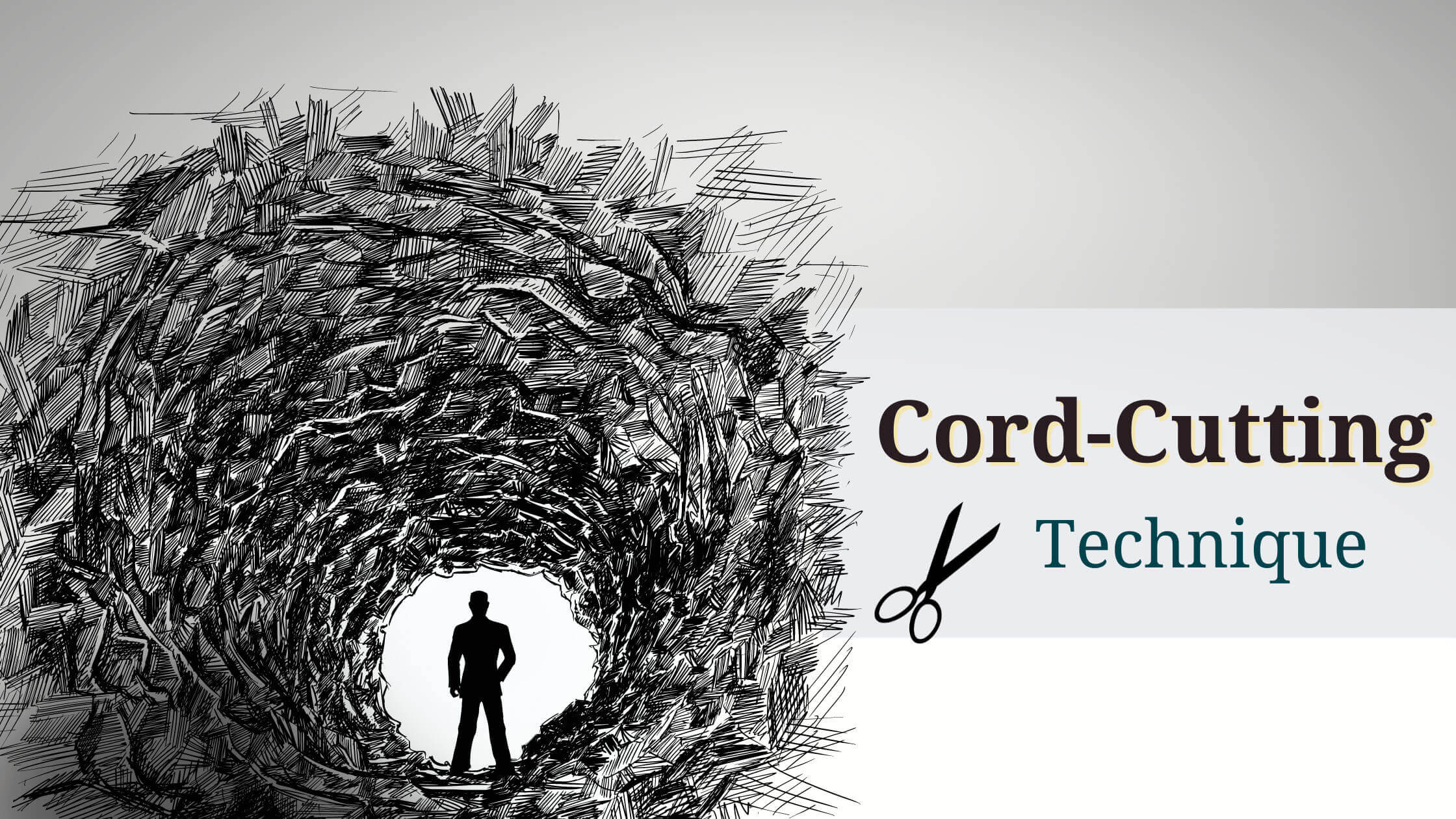Cord cutting is an innovative therapeutic technique gaining traction among psychologists and therapists for its powerful approach to emotional and psychological healing. This method, deeply rooted in spiritual and metaphysical traditions, has been adapted to modern therapeutic practices to help individuals sever unhealthy emotional attachments.
In this comprehensive guide, we explore the concept of cord cutting, its application in therapy, and its integration within Cognitive Hypnotic Psychotherapy (CHP). We also provide a detailed step-by-step process for implementing cord cutting with a focus on belief work.
Understanding Cord Cutting
Concept of Cord Cutting
Cord cutting is a symbolic therapeutic technique designed to help individuals release emotional or energetic ties that connect them to past relationships, events, or situations.
These metaphorical “cords” represent lingering emotional connections that can continue to influence one’s mental and emotional state long after the relationship or event has ended. By severing these cords, therapists can facilitate emotional release and promote psychological healing.
Historical and Spiritual Roots
Historically, cord cutting is rooted in various spiritual and metaphysical practices, including shamanism, Eastern philosophies, and energy healing. These traditions believe that individuals form energetic connections with others that can affect their personal energy fields.
Modern psychological practices adapt these concepts to provide a symbolic and practical approach to emotional healing and personal growth.
Psychological Perspective
In the context of psychology, cord cutting is seen as a metaphorical tool for addressing unresolved emotional issues and unhealthy attachments. It aligns with therapeutic goals such as emotional release, boundary-setting, and personal empowerment.
By integrating cord cutting with Cognitive Hypnotic Psychotherapy (CHP), practitioners can enhance their therapeutic toolkit with a multifaceted approach that addresses various dimensions of a client’s emotional and psychological landscape.
Application of Cord Cutting in Therapy

Identifying the Need for Cord Cutting
The first step in the cord-cutting process is to identify the specific emotional attachments or unresolved issues that are impacting the client. Techniques such as introspective questioning, journaling, and therapeutic dialogue can help uncover these connections.
For instance, a client might need to address persistent negative emotions or unresolved issues related to past relationships.
Techniques and Methods
- Visualization and Guided Imagery
Visualization is a central technique in cord cutting. Therapists guide clients through a meditative process where they visualize the emotional or energetic cords connecting them to the person or situation in question. This imagery allows clients to symbolically sever the ties and release associated emotional burdens. Visualization can be particularly effective when combined with Cognitive Hypnotic Psychotherapy, leveraging both symbolic and hypnotic techniques to facilitate deeper emotional release. - Rituals and Symbolic Actions
Incorporating rituals or symbolic actions can enhance the effectiveness of cord cutting. Clients might use symbolic objects like scissors or knives to represent cutting the cords. Writing letters or creating symbolic representations of the cords and then destroying them can also serve as powerful tools in this process. These rituals provide a tangible way for clients to engage in the therapeutic process. - Affirmations and Positive Reframing
Affirmations are crucial in reinforcing the client’s commitment to releasing unhealthy attachments. Therapists work with clients to create affirmations that emphasize empowerment, self-worth, and closure. Positive reframing helps clients alter their perceptions and experiences, promoting a healthier emotional state.
Step-By-Step Process of Cord Cutting with Belief
- Identifying the Limiting Belief
Begin by identifying the limiting belief that needs to be addressed. For example, consider the belief “I am not worthy.” Techniques from Cognitive Hypnotic Psychotherapy, such as introspective questioning and cognitive restructuring, can help uncover these beliefs. - Inducing a Hypnotic State
Guide the client into a hypnotic state. If you are not familiar with hypnotic induction techniques, you can use a guided meditation or relaxation process. Both methods can effectively induce a hypnotic state, allowing the client to access deeper levels of their subconscious mind. - Visualization of the Tunnel
Instruct the client to visualize entering a tunnel with a white light at the end. Ask them to walk through the tunnel until they reach the center. This visualization sets the stage for the cord cutting process and can be enhanced using Cognitive Hypnotic Psychotherapy techniques for deeper engagement. - Identifying the Cord
At the tunnel’s center, have the client look down and notice a translucent cord extending from their body into the white light. Explain that this cord is connected to their limiting belief. - Pulling the Limiting Belief
Suggest that the cord is connected to their limiting belief. Ask the client to pull on the cord until they see a cloud with the limiting belief (e.g., “I am not worthy”). This step involves using visualization to bring the limiting belief into focus. - Cutting the Cord
Instruct the client to find a giant pair of scissors in the tunnel and use them to cut the cord as close to their body as possible. As the cord is cut, suggest that the limiting belief cloud flies off into the white light, symbolizing the release of the belief. - Healing and New Connection
After cutting the cord, have the client notice a band-aid in the tunnel. Ask them to apply it to the place where the cord was cut. Suggest that by the time they exit the tunnel, the wound will be healed. - Establishing a New Belief
Suggest that a new cord will form, connecting them to a new belief aligned with their desired outcome (e.g., “I am worthy”). Once the new cord is visible, instruct the client to walk back out of the tunnel. After emerging, the client should remove the band-aid, indicating the healing is complete. - Awakening
Gently bring the client back to full awareness. Ensure they feel refreshed and integrated, having released the limiting belief and established a new, positive belief.
Benefits of Cord Cutting
- Emotional Healing
Cord cutting facilitates emotional healing by enabling clients to release unresolved emotional ties and past grievances. This process helps individuals achieve greater emotional freedom and psychological well-being. - Enhanced Personal Growth
By severing unhealthy attachments, clients can focus on their personal growth and self-improvement. Cord cutting promotes healthier relationships, better self-awareness, and a stronger sense of identity. - Improved Relationship Dynamics
Clearing emotional baggage from past relationships can positively impact current and future relationships. Clients may find themselves more capable of forming authentic connections and setting healthier boundaries. - Reduction of Stress and Anxiety
Releasing unresolved emotional ties can reduce stress and anxiety levels. Clients often experience a greater sense of inner peace and emotional stability as a result of cord cutting.
Challenges and Considerations
- Readiness for Change
Clients must be ready and willing to let go of emotional attachments for cord cutting to be effective. A readiness to confront and release past issues is crucial for successful outcomes. - Integration of Insights
Proper integration of insights and changes achieved through cord cutting into daily life is essential. Without integration, clients may revert to old patterns or find it challenging to maintain progress. - Professional Guidance
Cord cutting should be conducted with professional guidance to ensure safety and effectiveness. Therapists trained in Cognitive Hypnotic Psychotherapy (CHP) can provide the necessary support, structure, and follow-up to maximize the benefits of the process.
Conclusion
Cord cutting is a valuable therapeutic technique that can significantly enhance emotional and psychological healing. By incorporating this technique within the framework of Cognitive Hypnotic Psychotherapy, psychologists can offer a comprehensive approach to addressing unhealthy emotional attachments and facilitating personal growth.
Through effective application and integration, cord cutting helps clients achieve lasting emotional freedom, improved relationships, and enhanced well-being.

